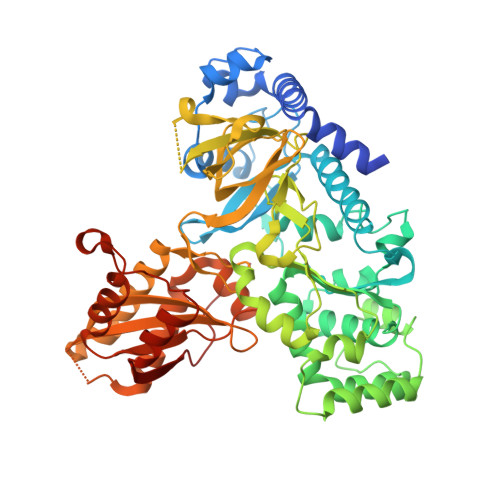Crystal structure of the acyl acid amido synthetase GH3-8 from Oryza sativa.
Xu, G., Zhang, Y., Li, M., Jiao, X., Zhou, L., Ming, Z.(2021) Biochem Biophys Res Commun 534: 266-271
- PubMed: 33272567
- DOI: https://doi.org/10.1016/j.bbrc.2020.11.098
- Primary Citation of Related Structures:
7DK8 - PubMed Abstract:
The Gretchen Hagen 3 (GH3) family of acyl acid amido synthetases regulate the levels and activities of plant hormones containing carboxyl groups, thereby modulating diverse physiological responses. While structure-function relationships have been elucidated for dicotyledonous GH3s, the catalytic mechanism of monocotyledonous GH3 remains elusive. Rice (Oryza sativa) is a representative monocot, and its yield is controlled by the natural growth hormone IAA (indole-3-acetic acid). OsGH3-8 is a model GH3 enzyme that conjugates excess IAA to amino acids in an ATP-dependent manner, ensuring auxin homeostasis and regulating disease resistance, growth and development. Here, we report the crystal structure of OsGH3-8 protein in complex with AMP to uncover the molecular and structural basis for the activity of monocotyledonous GH3-8. Structural and sequence comparisons with other GH3 proteins reveal that the AMP/ATP binding sites are highly conserved. Molecular docking studies with IAA, the GH3-inhibitor Adenosine-5'-[2-(1H-indol-3-yl)ethyl]phosphate (AIEP), and Aspartate provide important information for substrate binding and selectivity of OsGH3-8. Moreover, the observation that AIEP nearly occupies the entire binding site for AMP, IAA and amino acid, offers a ready explanation for the inhibitory effect of AIEP. Taken together, the present study provides vital insights into the molecular mechanisms of monocot GH3 function, and will help to shape the future designs of effective inhibitors.
- State Key Laboratory for Conservation and Utilization of Subtropical Agro-bioresources, College of Life Science and Technology, Guangxi Key Laboratory for Sugarcane Biology, Guangxi University, Nanning, 530004, PR China.
Organizational Affiliation:

















